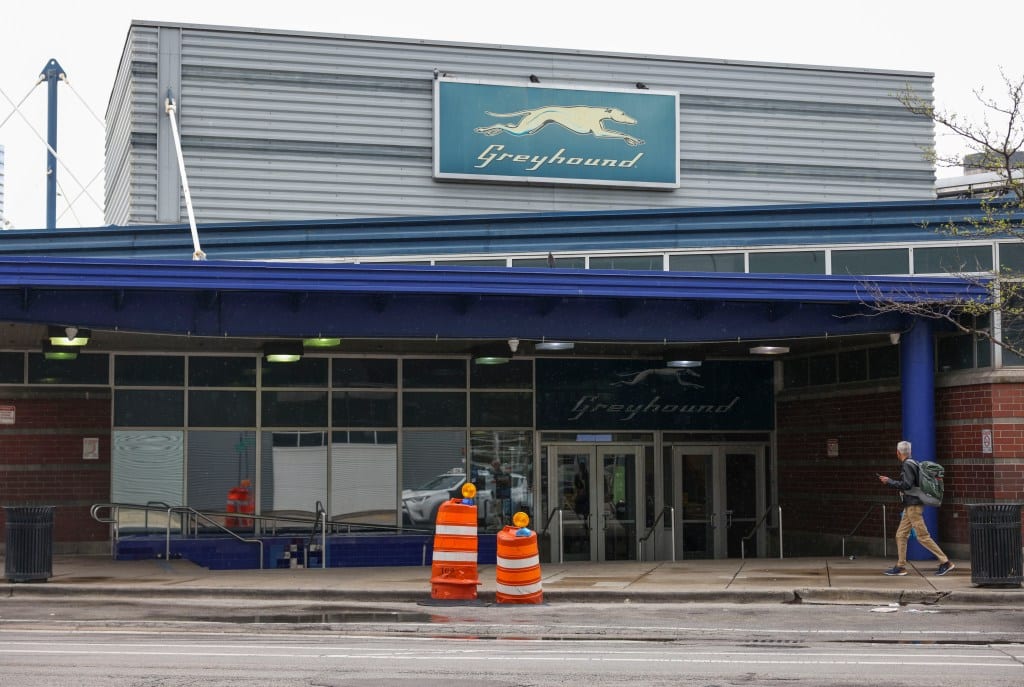DePaul University’s Chaddick Institute for Metropolitan Development put out a report Monday that garnered all kinds of media attention. In it, lead author Joseph Schwieterman argues that the city has been asleep at the wheel when it comes to finding a new bus station to replace the Greyhound bus station at 630 W. Harrison St. The famous long-distance bus company is losing its lease in October, when the valuable site is expected to be redeveloped for residential use. The report used the language of catastrophe: “The Illinois intercity bus system is on the verge of crisis due to Chicago Greyhound Station’s potential closure within months,” it reads. “Several months of planning will be needed to avoid a chaotic transition.”
Some background: From 1953 through 1989, Greyhound was located at the corner of Clark and Randolph streets with direct access to Lower Wacker Drive. When that site was redeveloped, the company moved to a smaller station on Harrison, which offered quick access to the expressway but also was seen at the time as a less-than-desirable, out-of-the-way location. Since then, the area around the station has increased in value, especially as a place to build condos. So here we are again.
The DePaul institute report eloquently lays out the argument for having intercity bus travel, which it sees as appropriate for a state subsidy on the grounds of its importance to low-income Illinoisans. But it spends less time on the related traumas of the intercity bus industry itself. In the early 1980s, Greyhound operated nearly 4,000 buses and was a regular site on Illinois expressways (as was Continental Trailways, a competitor until Greyhound bought it in 1987). You could take a direct bus from Chicago to virtually all major U.S. cities.
Since then, Greyhound hit a series of ever-harder times. There were numerous bitter labor disputes, and by 1990, Greyhound had filed for bankruptcy. When it emerged in 1991, it had greatly shrunk in size. The Canadian company Laidlaw bought Greyhound in 1998. In 2001, Laidlaw itself went through bankruptcy reorganization, and there were further drastic route cuts in 2004. Another owner came and went, and then, in 2021, Munich-based FlixBus bought Greyhound.
All of this is to say that if you don’t regularly take Greyhound, you might not know how diminished your route choices are from the days tourists bought Ameripasses and the seats in Greyhound’s terminals had tiny TVs attached. You can’t take a nonstop Greyhound from Chicago to New York anymore. Los Angeles involves two transfers. Miami now means a change in Atlanta.
The actual Greyhound stations in most cities have been sold off. Chicago hardly is unusual there.
That said, intercity bus service is far from dead. In fact, high-end boutique services recently have emerged in New York and Texas offering passengers high-speed Wi-Fi, sleeper seats and food service at their seats. We could imagine such buses offering services from Chicago to Detroit, Minneapolis and St. Louis. Or maybe to Michigan beach towns in the summer.
Entrepreneurs see new opportunities: People don’t mind sitting on buses now when they can work remotely or watch movies on their devices. But companies such as Megabus long ago popularized the approach of picking passengers up on sidewalks and not from costly stations. And the new luxe services tend to use downtown hotels as their terminals, not old-school bus stations with diners and interesting characters inside.
So, no, the city does not have to find or operate a costly retro station for a scale of service that no longer exists, and it should not put all of its bus chips on the dog. But it does have to find a spot for the roughly three departures (and three arrivals) an hour at Harrison Street. Most bus travelers are making onward journeys, so Union Station is the logical spot. It has local connections, and it’s up for redevelopment.
We’ve been eyeing the CTA bus station on the opposite side of Jackson Street from Union Station. It seems to us underused. That’s an option. So is Canal Street. The relatively simple goal should be to make space by Union Station for multiple intercity bus companies, given the long-standing traumas of the industry, while also offering passengers the facilities of a major station, especially in winter.
That’s a win-win-win for retail businesses, bus operators and passengers. And it’s not hard to accomplish.
Submit a letter, of no more than 400 words, to the editor here or email letters@chicagotribune.com.


